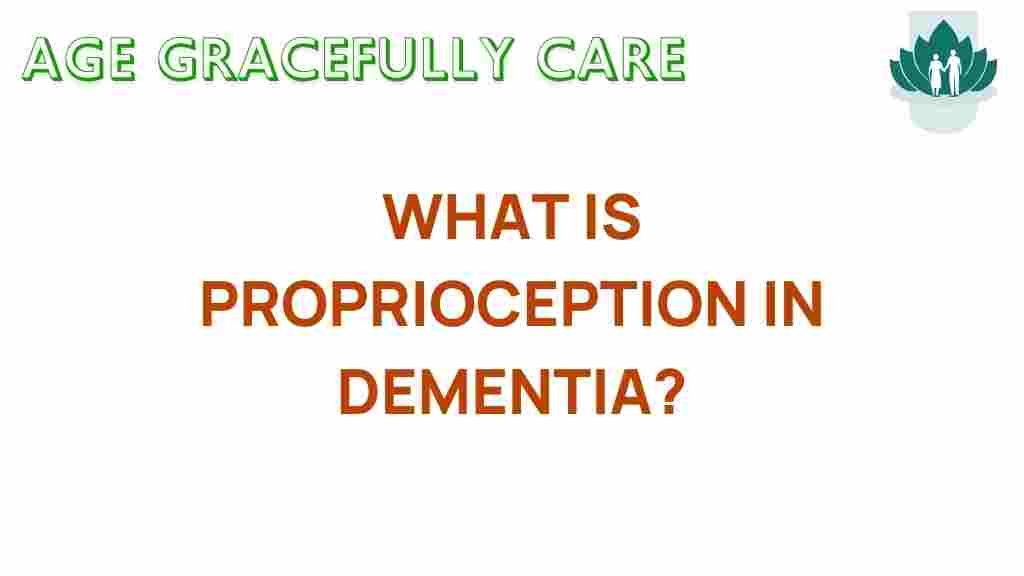Unlocking the Mystery: What is Proprioception in Dementia?
Proprioception is a critical aspect of our sensory perception, allowing us to understand the position and movement of our body in space. This sense is particularly important for maintaining balance and coordination. In the context of dementia, an understanding of proprioception becomes vital as cognitive decline impacts neurological health and movement awareness in affected individuals. This article delves into the intricate relationship between proprioception and dementia, exploring how these factors influence elderly care and rehabilitation.
Understanding Proprioception
Proprioception, often referred to as the “sixth sense,” is the body’s ability to perceive its position and movement. It involves sensory receptors located in the muscles, tendons, and joints that send information to the brain about body positioning. This sensory input helps us maintain balance and perform coordinated movements without needing to look at our limbs or body parts.
The Role of Proprioception in Balance
Balance is a complex interplay of sensory inputs, including proprioception, vision, and vestibular (inner ear) information. Individuals with intact proprioceptive abilities can make quick adjustments to maintain stability. However, as dementia progresses, these abilities may deteriorate. Some key points regarding proprioception and balance include:
- Integration of Sensory Input: Proprioception works in conjunction with other senses to create a comprehensive understanding of body position.
- Movement Awareness: Effective proprioception allows for smooth and coordinated movements, essential for daily activities.
- Risk of Falls: Impaired proprioception increases the risk of falls, a significant concern in elderly care.
How Dementia Affects Proprioception
Dementia, characterized by cognitive decline, affects various brain functions, including those responsible for processing proprioceptive information. Here are some ways dementia impacts proprioception:
- Neurological Changes: The degeneration of brain cells disrupts communication pathways, leading to a diminished ability to process sensory information.
- Impaired Movement Awareness: Individuals may struggle to recognize their body’s position, leading to clumsiness and a loss of balance.
- Cognitive Challenges: Difficulty in planning and executing movements can stem from cognitive impairments, further complicating proprioceptive feedback.
Recognizing Proprioceptive Deficits in Dementia Patients
Identifying proprioceptive deficits in dementia patients is crucial for developing effective care strategies. Here are signs that may indicate compromised proprioception:
- Frequent stumbling or falling.
- Inability to perform tasks that require hand-eye coordination.
- Difficulty standing up from a seated position without support.
- Awkward or uncoordinated movements.
Step-by-Step Guide to Assessing Proprioception in Dementia
Assessing proprioception in individuals with dementia involves a careful approach. Here’s a step-by-step guide:
- Initial Observation: Observe the individual’s movements during daily activities. Look for signs of imbalance or awkwardness.
- Simple Balance Tests: Conduct simple tests, such as asking the individual to stand on one foot or walk heel-to-toe.
- Coordination Tasks: Introduce coordination tasks, like reaching for objects or catching a ball. Monitor their ability to perform these tasks smoothly.
- Feedback and Communication: Discuss observations with the individual or their caregivers to understand their experiences related to movement awareness.
- Consult a Professional: If deficits are suspected, consult a healthcare professional for a comprehensive assessment.
Rehabilitation Strategies for Enhancing Proprioception in Dementia
Rehabilitation plays a vital role in improving proprioception and overall movement awareness in dementia patients. Here are some effective strategies:
- Physical Therapy: Engage in physical therapy programs focusing on balance, strength, and coordination exercises.
- Occupational Therapy: Occupational therapists can help modify daily activities to enhance safety and independence.
- Balance Training: Introduce balance training exercises, such as Tai Chi or yoga, which are beneficial for improving stability.
- Sensory Stimulation: Use activities that stimulate proprioceptive senses, like walking on different textures or using resistance bands.
- Routine Establishment: Establishing daily routines can help individuals with dementia feel more secure and aware of their movements.
Challenges in Rehabilitation for Dementia Patients
While rehabilitation is essential, several challenges may arise:
- Cognitive Limitations: Cognitive decline may hinder the patient’s ability to follow instructions.
- Resistance to Change: Patients may resist new activities or exercises due to fear or confusion.
- Physical Limitations: Other health issues may complicate mobility and participation in rehabilitation programs.
Troubleshooting Tips for Caregivers
Caregivers play a crucial role in supporting proprioceptive awareness in dementia patients. Here are some troubleshooting tips:
- Be Patient: Progress may be slow, and it’s essential to be patient and encouraging.
- Use Visual Aids: Incorporate visual aids or demonstrations to enhance understanding of tasks.
- Modify Activities: If a particular activity is challenging, modify it to suit the individual’s abilities.
- Celebrate Small Achievements: Acknowledge and celebrate even the smallest improvements to boost confidence.
Conclusion
Understanding proprioception in the context of dementia is crucial for enhancing balance and movement awareness among affected individuals. As cognitive decline progresses, proprioceptive abilities may diminish, leading to challenges in daily activities and an increased risk of falls. By recognizing the importance of proprioception, caregivers and healthcare providers can implement effective rehabilitation strategies that promote neurological health and improve the quality of life for those living with dementia.
For more information on elderly care and rehabilitation techniques, visit this resource. Additionally, stay updated on the latest research in dementia and proprioception through external studies.
This article is in the category Health and created by AgeGracefullyCare Team
